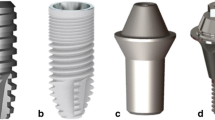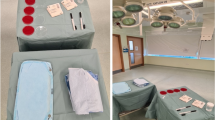Abstract
Aims
To determine whether the radiopaque marker strip, which is woven in surgical swabs, causes measureable wear on metal implants at pressures typically used to wipe off fluid from their surface.
Materials and methods
Finger pressure used to wipe a surface was measured and used as a reference pressure for further testing. A tribological wear rig was then used to analyse the wear caused on polished titanium plates by a cobalt chromium pin (the control test), the pin covered by a surgical swab and the pin covered by a radiopaque marker strip.
Results
It was found that the cotton part or the radiopaque marker of surgical swabs on polished medical grade titanium plates caused no significant wear. In contrast severe scratching was observed from the cobalt chromium pin on its own.
Conclusion
To our knowledge, this is the first study in the literature analysing the wear caused by the surgical swabs and radiopaque strip on metal implants. The results suggest that surgical swabs are safe to use on metallic implants at pressures typical of a wiping motion.






Similar content being viewed by others
References
Lauwers PR, Van Hee RH (2000) Intraperitoneal gossypibomas: the need to count sponges. World J Surg 24:521–527
Sadeghifar AR, Saeed AR (2013) Infected textiloma, 35 years after the operation for femur fracture, an extremely rare occurrence. Arch Bone Jt Surg 1:41–43
Takigami I, ItohY Itokazu M, Shimizu K (2008) Radio-opaque marker of a surgical sponge appearing as an intra-articular foreign body after total hip arthroplasty. Arch Orthop Trauma Surg 128:1167–1168
Sansone V, Pagani D, Melato M (2013) The effects on bone cells of metal ions released from orthopaedic implants. A review. Clin Cases Miner Bone Metab 10:34–40
Archard Equation. Wikipedia. https://en.wikipedia.org/wiki/Archard_equation. Accessed 18 Aug 2018
Archard JF (1953) Contact and rubbing of flat surfaces. J Appl Phys 24:981–988
Archard JF, Hirst W (1956) The wear of metals under unlubricated conditions. Proc R Soc Lond Ser A 236:397–410
Billi F, Campbell P (2010) Nanotoxicology of metal wear particles in total joint arthroplasty: a review of current concepts. J Appl Biomater Biomech 8:1–6
Besong AA, Jin ZM, Fisher J (2001) Importance of pin geometry on pin-on-plate wear testing of hard-on-hard bearing materials for artificial hip joints. Proc Inst Mech Eng Part H 215:605–610
Ingram JH, Stone MH, Fisher J, Ingham E (2004) The influence of molecular weight, crosslinking and counterface roughness on TNF-alpha production by macrophages in response to ultra high molecular weight polyethylene particles. Biomaterials 25:3511–3522
Muratoglu OK, Greenbaum ES, Bragdon CR, Jasty M, Freiberg AA, Harris WH (2004) Surface analysis of early retrieved acetabular polyethylene liners: a comparison of conventional and highly crosslinked polyethylenes. J Arthroplasty 19:68–77
Davidson JA (1993) Characteristics of metal and ceramic total hip bearing surfaces and their effect on long-term ultra high molecular weight polyethylene wear. Clin Orthop Relat Res 294:361–378
Cobb AG, Schmalzreid TP (2006) The clinical significance of metal ion release from cobalt-chromium metal-on-metal hip joint arthroplasty. Proc Inst Mech Eng Part H 220:385–398
Watters TS, Cardona DM, Menon KS, Vinson EN, Bolognesi MP, Dodd LG (2010) Aseptic lymphocyte-dominated vasculitis-associated lesion: a clinicopathologic review of an underrecognized cause of prosthetic failure. Am J Clin Pathol 134:886–893
Harris WH (1995) The problem is osteolysis. Clin Orthop Relat Res 311:46–53
Haynes DR, Crotti TN, Potter AE, Loric M, Atkins GJ, Howie DW, Findlay DM (2001) The osteoclastogenic molecules RANKL and RANK are associated with periprosthetic osteolysis. J Bone Joint Surg Br 83:902–911
Acknowledgements
This work was supported by the NIHR (National Institute for Health Research) through funding of the LMBRU (Leeds Musculoskeletal Biomedical Research Unit).
Author information
Authors and Affiliations
Corresponding author
Ethics declarations
Conflict of interest
The authors declare that they have no competing interests.
Rights and permissions
About this article
Cite this article
Theodorides, A.A., Stewart, T.D. & Venkatesh, R. Can the radiopaque marker in surgical swabs scratch orthopaedic implant surfaces?. Eur J Orthop Surg Traumatol 29, 383–388 (2019). https://doi.org/10.1007/s00590-018-2309-5
Received:
Accepted:
Published:
Issue Date:
DOI: https://doi.org/10.1007/s00590-018-2309-5




